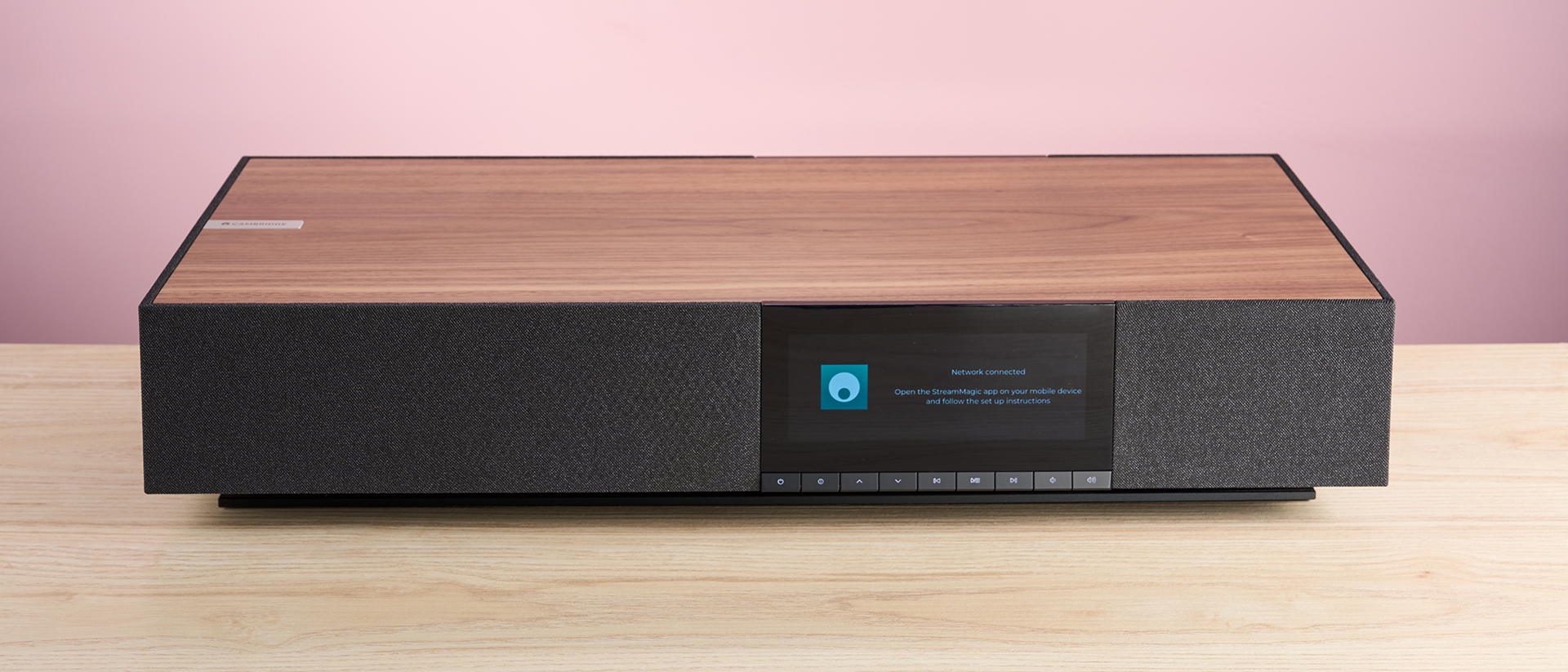TechRadar Verdict
Not only is the Cambridge Audio Evo One able to deliver a range of audio sources – whether it's lossless streaming, phono from a turntable, or even from your TV via eARC – it also delivers on sound quality. From FLACs to vinyl, it makes your music sound gorgeous, with full, exquisitely controlled bass, expressive mids and precise trebles. It’ll also look right at home alongside your furniture, thanks to its high-end materials and solid build. While it’s undeniably pricey, it’s still very hard to beat.
Pros
- +
Gorgeous hi-res sound
- +
Incredibly wide feature set
- +
Premium, stylish design
Cons
- -
Not the widest soundstage
- -
Bit of a behemoth
- -
Far from cheap
Why you can trust TechRadar
Cambridge Audio Evo One: two-minute review
The Cambridge Audio Evo One is a high-end wireless speaker that's capable of playing audio at up to 32-bit/192kHz. But that’s really only part of the picture: it’s also a multi-room speaker, an internet radio, a soundbar, and a turntable phono stage. It’s almost quicker to list the things it can’t do. The Evo One packs a lot of skills into its substantial frame, making it a natural choice for anyone who wants to cover every base but doesn’t have the space or the cash to splash on buying a whole system of hi-fi separates.
Once the Cambridge Audio Evo One was optimized for my listening space – you can manually adjust its sound for the reflectivity of your room and its distance from the wall – it rewarded me with lush, well-rounded sound. The low end is warm and yet tight – there’s none of the unfortunate swampiness you get with cheaper, bass-heavy speakers. Meanwhile, trebles are well handled, neither succumbing to timidity nor becoming so strident that they grate. This means that rather than facing off aggressive overtures from above and below, the mids are allowed the proper space to express themselves, letting the harmonics of vocals and instruments shine.
The Evo One’s separation is right up there with the best wireless speakers on the market. Listening to Wasting My Young Years by London Grammar was a revelation – the strings are beautifully expressed, feeling vibrant despite their low volume, while the reverb on those gorgeous vocals is given plenty of room to breathe. Its soundstage isn’t quite as impressive though: it offers decent stereo spread without extending far beyond the bounds of the unit, but any single-unit speaker is never going to beat a true pair of the best stereo speakers.
Pitch-perfect streaming is just one of this speaker’s talents though: it offers a wide range of additional sources, from internet radio to TV audio via eARC. To test its mettle when it comes to movie audio, I hooked it up via HDMI and watched Ari Aster’s Midsommar – it expertly handled the swelling drone of its forbidding bass, while giving dialogue sufficient clarity and presence. Using its built-in phono stage, I also hooked up my turntable and span a selection of records – it did an excellent job with the likes of Black Sands by Bonobo and Kingdoms In Colour by Maribou State, expressing both with plenty of dynamism and clarity.
When it comes to design, the Cambridge Audio Evo One is hardly the kind of speaker you’ll want to hide away – its charcoal speaker mesh and smooth walnut surface make it an item of furniture you’ll want to show off, and I certainly felt that it earned pride of place in my living room.
Meanwhile, its front display gives you a stronger connection to the artist you’re listening to, although it’s not quite as bright as I’m used to in this era of ubiquitous 1,000-nit phone screens. However, let's be clear that you probably should think of it as an item furniture – it's big.
With its wide array of connectivity options, polished, poised audio and sophisticated looks, the Cambridge Audio Evo One is a worthwhile purchase, even taking into account its not inconsiderable price. Personally, I’m happy to give the Cambridge Audio Evo One a full-throated endorsement, and I doubt you’ll be disappointed with its performance or capabilities. If you want something that's also wonderful for sound but less expensive, the Bowers & Wilkins Zeppelin Pro is also a highly capable wireless speaker for nearly half the price.
Cambridge Audio Evo One review: price & release date
- Released on August 9, 2024
- List price is $1,499 / £1,299 / AU$2,495
The Cambridge Audio Evo One was released on August 9, 2024. It retails for $1,499 / £1,299 / AU$2,495 for this single unit – that's not exactly the cheapest price you’ll find a wireless speaker going for, but once you scratch the surface of the things this device can do, that asking price becomes much more reasonable. When a speaker is this capable, you really are paying for what you get.
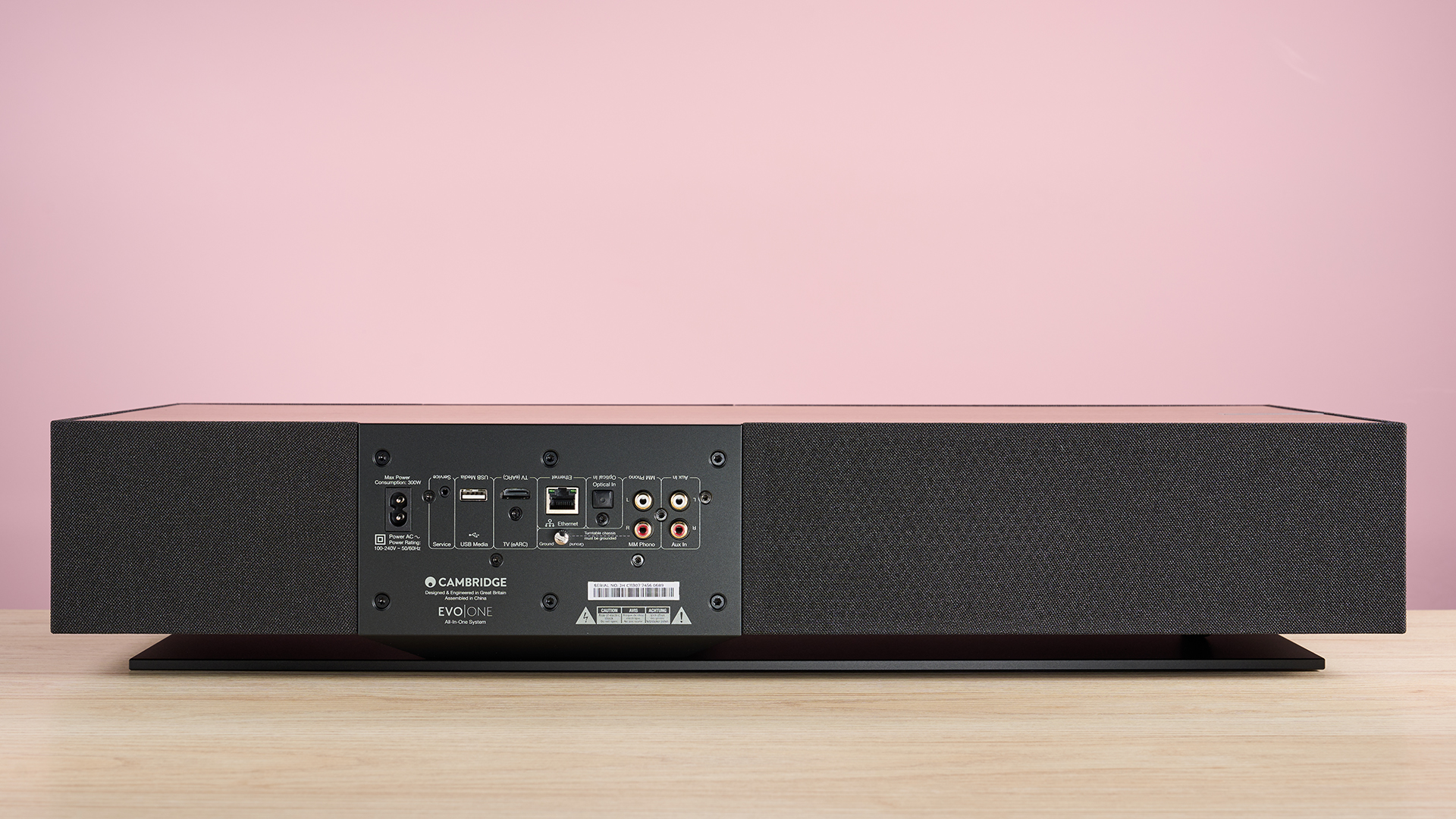
Cambridge Audio Evo One review: specs
Speaker drivers | 4 x 1-inch silk dome tweeters, 4 x 2.25-inch aluminum cone mid-range drivers, 6 x 2.75-inch long-throw woofers |
Amplification | 700W (14 x 50W) |
Dimensions | 26.6 x 5.1 x 11.4 inches (675 x 129 x 290mm) |
Connectivity | Wi-Fi 5, Bluetooth 5.1, USB-C, eARC, TOSlink, Ethernet, line-in, phono-in |
Streaming support | Internet radio, Tidal Connect, Spotify Connect, Qobuz, Deezer, Google Cast, AirPlay 2, Roon Ready |
Other features | Multi-room streaming, room customization, inbuilt phono stage, 7-band EQ |
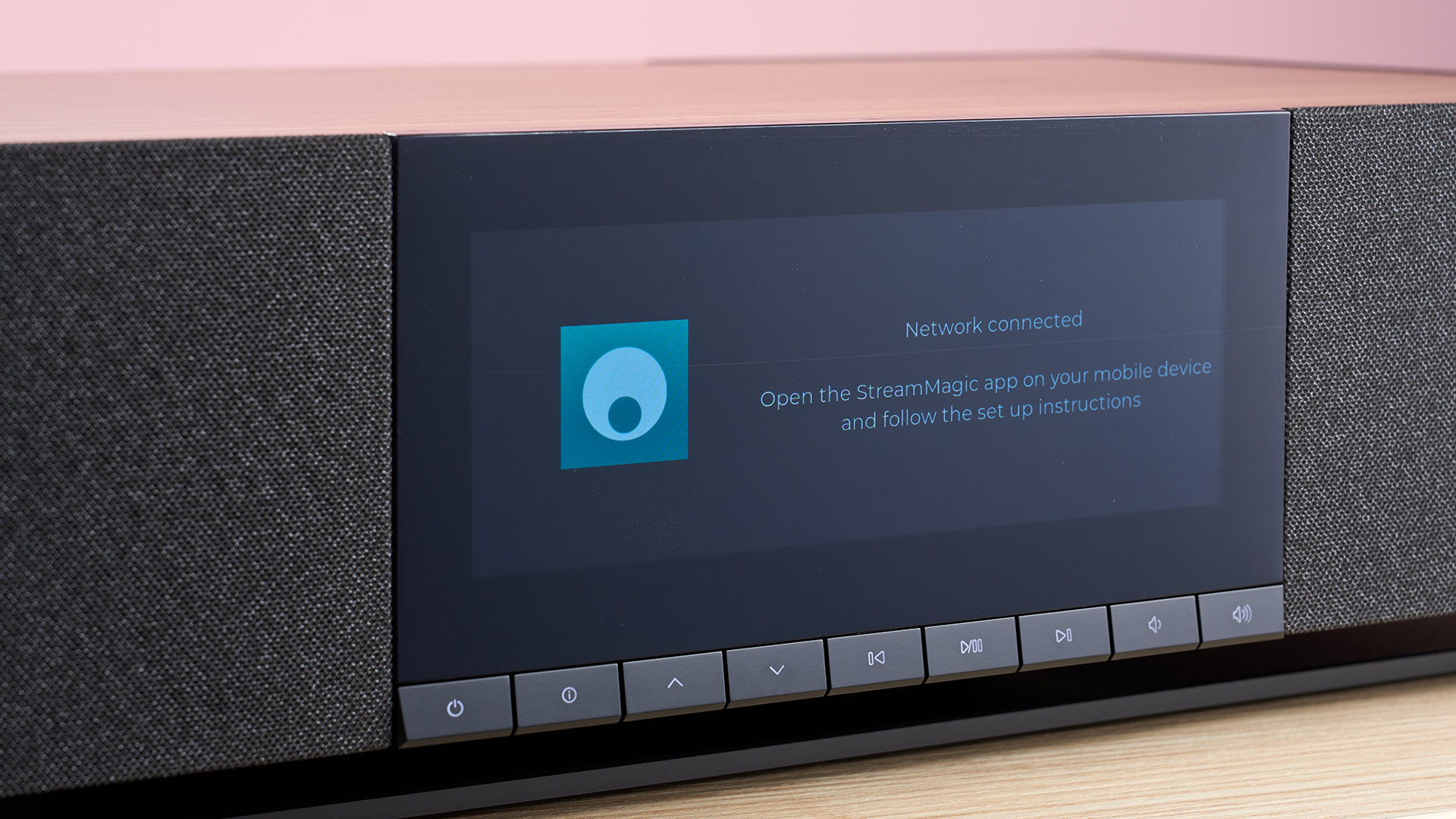
Cambridge Audio Evo One review: features
- Multi-talented feature set
- Crammed with well-amplified drivers
- Manual room optimization
Given its bulk, you won’t be surprised to hear that the Cambridge Audio Evo One is absolutely crammed full of drivers. It has 14 in total: four one-inch silk dome tweeters, four 2.25-inch aluminum cone mid-range drivers, and an utterly absurd six 2.75-inch long-throw woofers. Each of those drivers has 50W of amplification behind it, so it’s reasonable to expect that this beast is going to have gargantuan sound.
Such a well-furnished setup makes sense when you see how Cambridge Audio has positioned the Evo One. While it’s nominally a wireless speaker, it has plenty more tricks up its sleeve than just cueing up tunes from your Roon. Designed to sit at the heart of your home audio ecosystem, it really is a renaissance speaker, able to tackle the vast majority of listening tasks you throw at it.
First off, as well as offering Bluetooth 5.1 connectivity, it’s capable of streaming hi-res audio at up to 24-bit, 192kHz from streaming services, offering you significantly better quality than even CDs can muster. You can do this via built-in streaming services like Tidal and Spotify, or using its multi-room functionality to stream over Google Home, Apple AirPlay 2 and Roon. You can also stream radio over the internet, should you fancy letting someone else take over DJ responsibilities, or play direct via USB at the frankly ludicrous high quality of 32-bit/384kHz.
But its talents don’t stop there. Hook it up to your TV using an eARC cable and you can use it as a substitute soundbar – it won’t give you Dolby Atmos or height channels, but it will give your TV’s flimsy inbuilt sound a colossal boost. You can also hook up an external source through its RCA line-in, or plug one of the best turntables into its integrated phono stage and spin your records through it. It really does offer an astounding level of functionality that puts less gifted wireless speakers to shame.
Beyond sources, the Cambridge Audio Evo One offers some excellent functionality to help you polish the sound you’re getting. It offers a seven-band EQ to tailor its audio profile to your tastes – while this isn’t quite as versatile as the nine-band that some speakers offer, realistically it’s going to be plenty granular enough to tweak the sound balance.
Even more helpful are the Evo One’s room-calibration settings, which allow you to adjust its sound profile to account for how reflective your room is and how close the speaker is to a wall. I actually prefer this to the auto-calibration some speakers offer – it really allowed me to use my own judgement and knowledge of my space to get the sound just right, which I’m sure fellow audiophiles will appreciate.
All told, the Cambridge Audio Evo One is an incredibly well-specified speaker, offering a ton of functionality that even similarly high-end wireless speakers aren’t necessarily always capable of. If you’re just looking for a setup that allows you to stream hi-res audio, then maybe that will prove unnecessary window dressing, but if you’re looking for a Swiss Army Knife of a speaker that will sit at the heart of your home audio system, then it’s hard to argue with what’s on offer here.
- Features score: 5/5
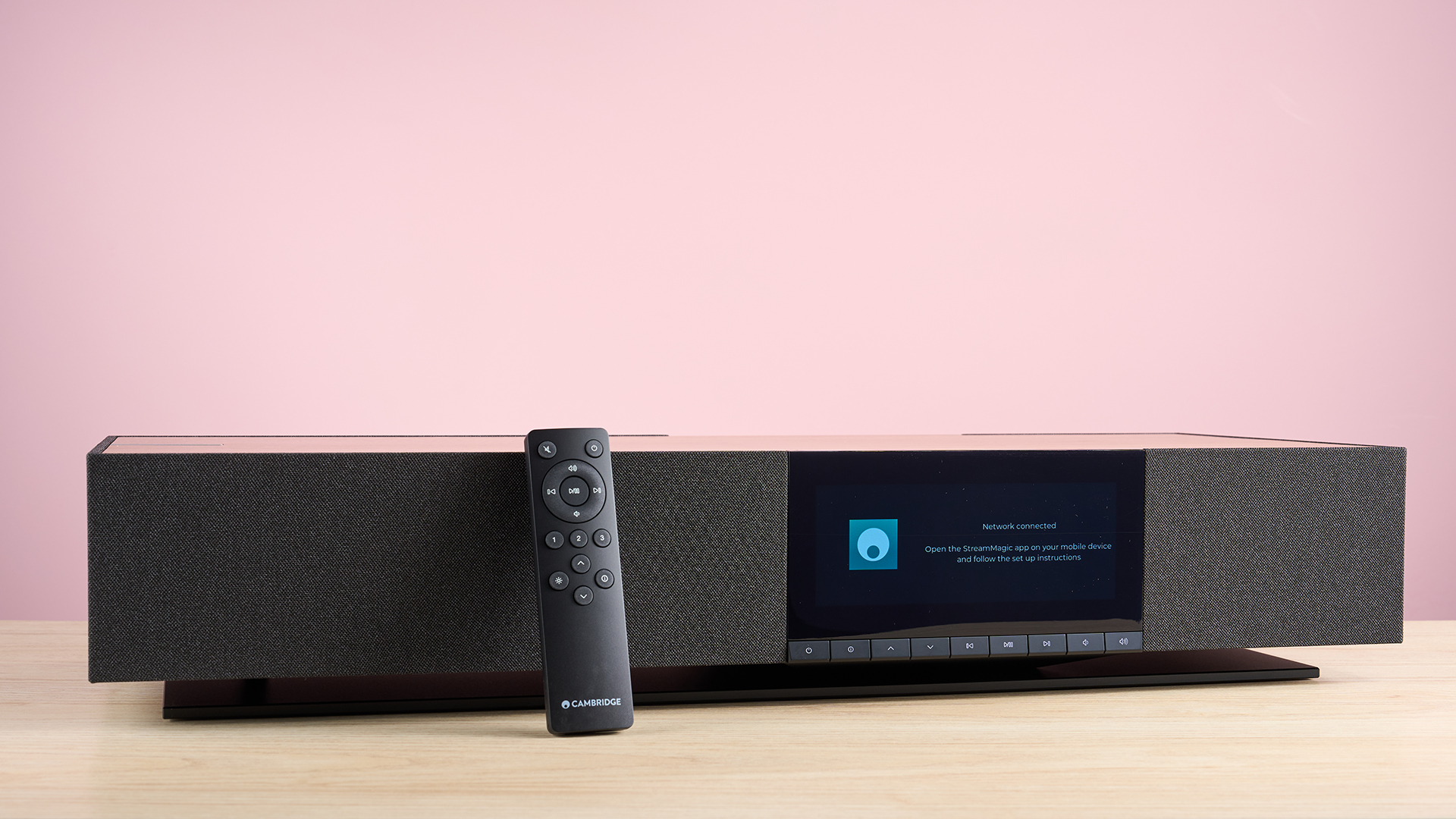
Cambridge Audio Evo One review: sound quality
- Once calibrated, it sounds beautifully well balanced
- Excellent separation
- Not the widest soundstage
Hand on heart, I was a bit underwhelmed by the Cambridge Audio Evo One’s sound at first. Listening to Black Eye by Allie X, the saw-edged bass synth sounded full but a little swampy, and there was a slightly echoey vibe to the kick, while a lot of the mix sounded muddier in the middle. That’s when I realised I hadn’t adjusted its room-optimization settings…
And boy, did tweaking those settings make a difference. Lowering the setting for room reflectivity and increasing the slider for how far the speaker was from the wall tamed the boom back and upped the transients. The bassline was tight while still being deliciously warm, the detail of the percussion became much more crisp, and the vocal rose above everything without obscuring anything. Suddenly it was like hearing my favorite songs for the first time, and it rapidly transformed my opinion of what this speaker is capable of.
Once properly calibrated, it’s not just the bass that sings; the rest of the frequency range sounds great too. When I listened to I Want You by Moloko, everything was so tightly integrated in the mids; that tight funky guitar lick and the timbre of the strings rang through clearly, while Róisín Murphy’s voice glued the whole mix together, from the nice warm sub end of the funky bass to the transient bite of the snare hits. And it masterfully handles songs that can be make or break in terms of treble – it deftly handles the crisp harmonics of the strummed guitars and snare and tom hits on You Can Go Your Own Way by Fleetwood Mac, while giving them sufficient body to stop the whole mix feeling aggressively bright.
But the Evo One isn’t just great at balancing different frequencies; it has real poise when it comes to separation as well. I stuck on Claire de Lune by Kamasi Washington and the results were exquisite. Those honey-sweet horns feel so richly textured that you could almost take a bite out of them, while the pluck of the double bass feels like it’s almost it’s in the room with you. Even the piano, oft overshadowed when listening to this mix on weaker speakers, cascades out when appropriate – everything has a palpable sense of space that makes everything feel much more real and evocative.
The Evo One doesn’t just handle digital audio sources well. I hooked up my Audio-Technica AT-LP60XBT turntable to the speaker via its built-in phono stage and cued up Kingdoms In Colour by Maribou State. The overall sound was faithful and gave everything a sizable presence and, while it wasn’t quite as remarkable as its hi-res audio output, I put this down more to my budget deck than the Evo One’s innate capabilities.
One area where this wireless speaker doesn’t quite trounce the competition though is its stereo soundstage. Don’t get me wrong: firing up Daydreaming by Radiohead I could absolutely appreciate how the snatches of Thom Yorke’s vocal echoed to the left and right, while the guttural reversed strings that end the track swam convincingly from side to side. However, unlike some speakers, including the Sonos Era 300, the sound doesn’t extend much beyond the confines of the cabinet, and there’s no attempt to convince you there’s real height here. I’d argue that’s not really its whole vibe though – the Evo One aims for hi-res sound that’s very well reproduced, rather than high-tech trickery.
To test how the Evo One handled TV audio, I wired it up to my TV via ARC and settled in to watch Ari Aster’s hallucinogenic horror Midsommar. The Evo One delivered an appreciable improvement over the TV’s built-in speakers, giving the movie’s ominous soundtrack much more warmth and gravitas; Voice Clarity mode in particular helped the speech in the movie ring clear, while letting the droning bass continue to create suspense. While not a home theater soundbar replacement – you’re not going to get Dolby Atmos height channels or significant width here – it certainly represents an upgrade over TV sound alone.
Ultimately, the sound on offer here is impressive, particularly given how many tools it has in its box. If you’re wanting a premium, single-unit speaker that will cover all the bases, this is likely your best bet at this price range.
- Sound quality: 4.5 / 5
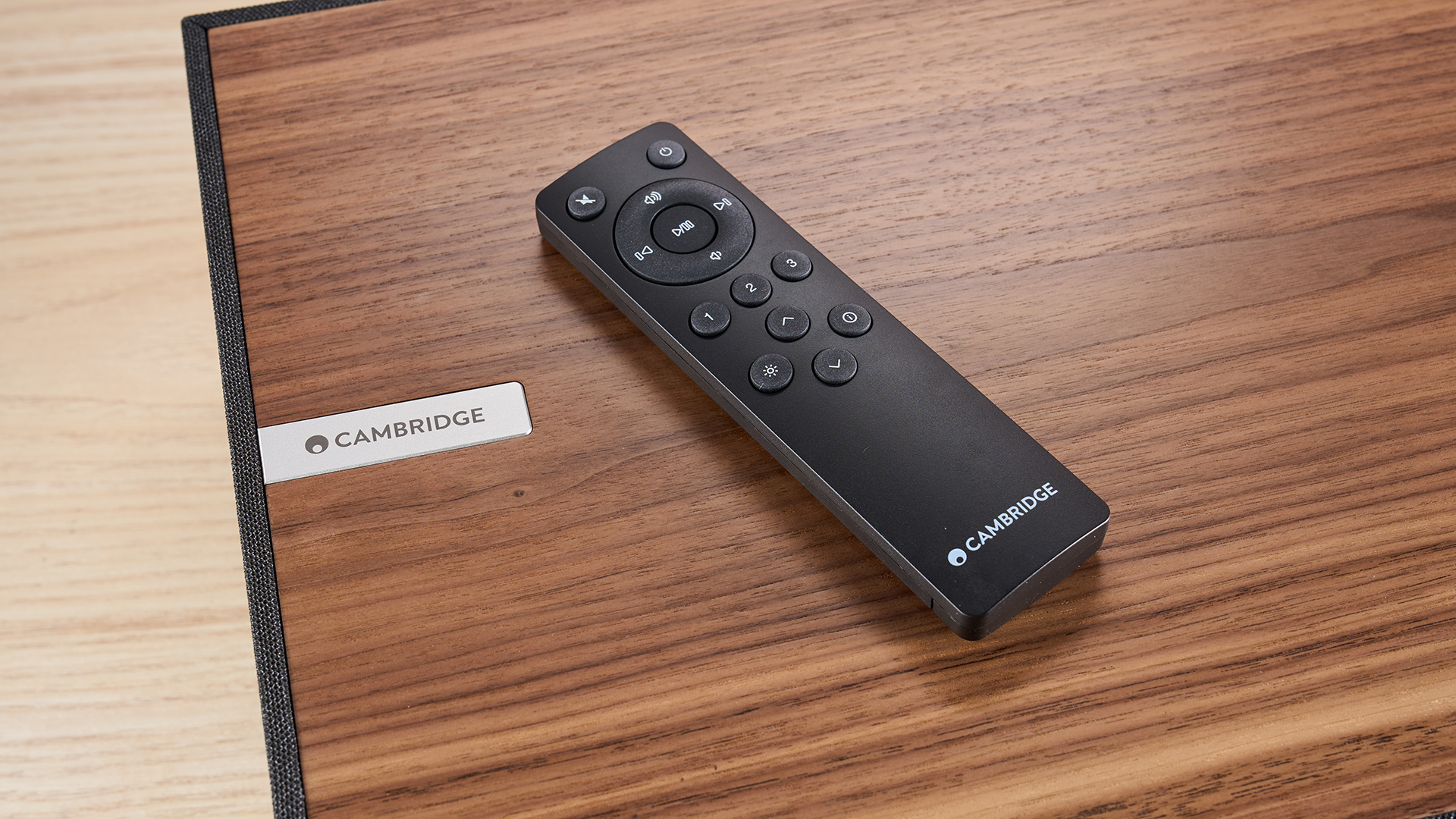
Cambridge Audio Evo One review: design
- Elegant, high-end design
- It’s a big fella
- Display is a little dim
In light of its price and the brand behind it, I’m sure I’m not going to shock anyone by saying that the Cambridge Audio Evo One offers smart, premium design. Everything about it is designed to form a focal point in your home, from its FSC-certified walnut panelling to its charcoal-colored fabric speaker grille. It definitely looks suitably high-end – although an alternate color would have been a great option to include, as beige cloth and a lighter wood such as birch or beech would look amazing alongside airier interiors.
Naturally, with all the drivers, amplification and other sundries inside its frame, this isn’t a small unit – in fact, at 26.6 x 5.1 x 11.4 inches / 675 x 129 x 290mm and 32lbs / 14.5kg, it’s a bit of a beast. But there’s something dependable about its big frame – it makes it feel like a genuine item of furniture that you’re pleased to show off. The only caveat here is if you want to place it in front of your TV to really take advantage of its eARC connectivity: it's no small fry height-wise, and will likely block the bottom of your screen, so you’ll want an entertainment unit that can accommodate both.
The main focal point of its front is the 6.8-inch, 1280 x 480 LCD display. Offering a range of options from track information and artwork to a stereo pair of VU meters, the display offers an attractive way of connecting more closely to the tunes you’re listening to. It’s not a very bright display, though, but expecting the kind of 1,000-nit HDR displays that have become commonplace in phones and tablets was always going to be a stretch. It’s plenty bright enough to carry out its intended function, even if you’re not going to be reveling in sumptuous, vibrant colors.
The Evo One’s remote control is well designed, nicely balancing functionality with simplicity. Standard controls are all idiot-proof – you can play, pause, skip forwards and backwards, raise and lower the volume, and power the unit on and off – but there are also some convenient presets that allow you to fire up your favorite sources, stations or playlists at the press of a button. You can also adjust the display’s brightness and switch between its various screens. You’ll need to reach for your phone to do anything particularly complex, but it's nice to be able to use it like a hi-fi separate when you want some screen-free time.
All in all, the Evo One oozes premium style, without too many unnecessary bells and whistles piled on top. Sure, the display could be brighter, and you’re out of luck if you're not into the dark wood and charcoal upholstery Cambridge Audio has opted for. But make no mistake: this is a luxury speaker that feels like an item of furniture in its own right.
- Design score: 4.5 / 5
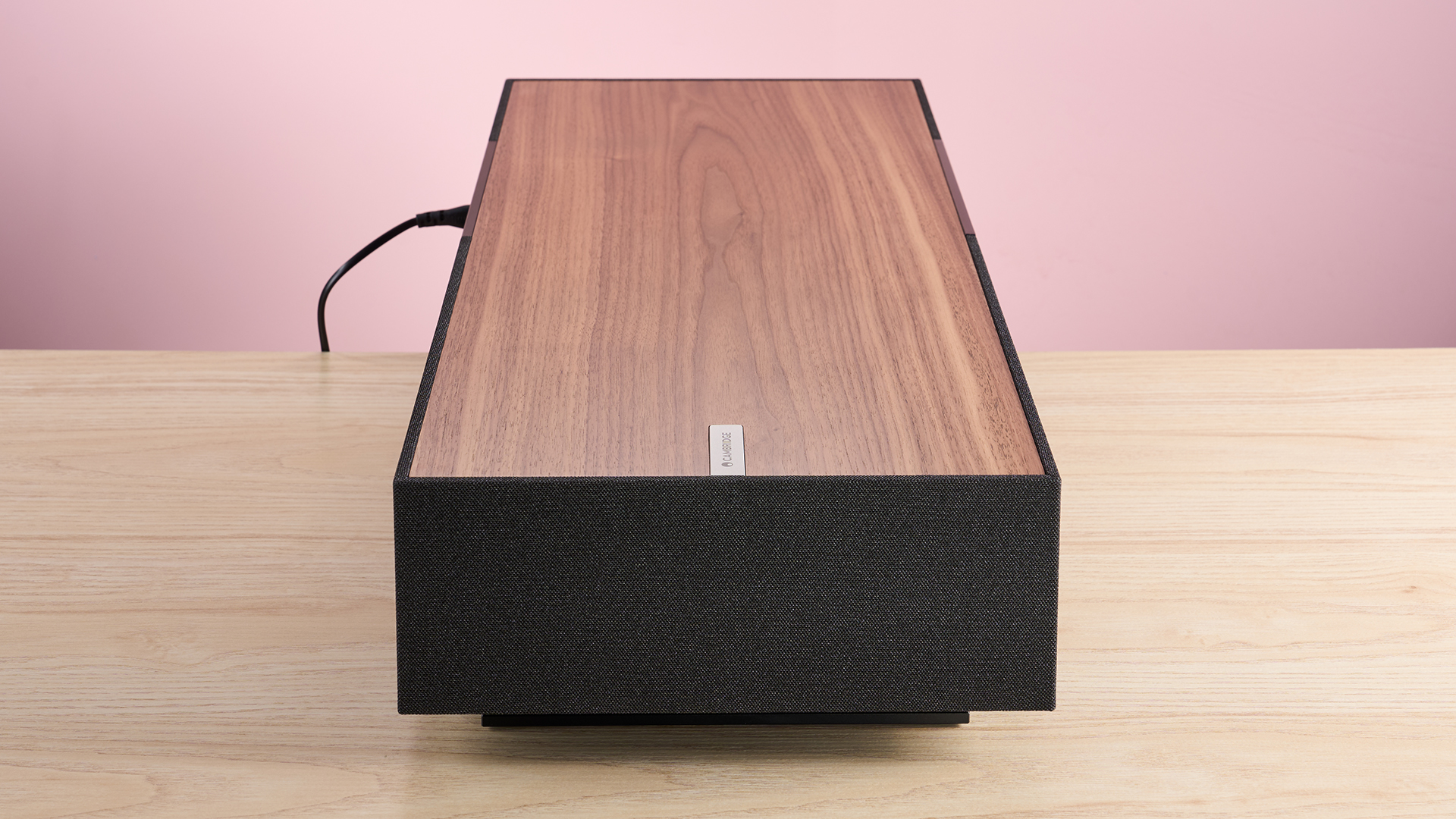
Cambridge Audio Evo One review: value
On the one hand, the Cambridge Audio Evo One is unarguably expensive for a single-unit speaker – $1,499 / £1,299 / AU$2,495 is not pocket change for anyone. On the other hand, this isn’t just a single-unit speaker. When you view the Evo One in terms of all of the gadgets it potentially replaces – wireless speaker, streamer, soundbar, phono stage – the value equation shifts significantly in its favor. For the price, it’s incredibly versatile, and is an excellent all-in-one option for someone who finds a whole range of hi-fi separates too extravagant an investment in terms of money and/or space.
And there are few rivals that can beat it for value. For example, while the Naim Mu-so 2nd Gen offers a premium, single-unit speaker for $1,299 / £899 / AU$1,299, it doesn’t have a screen, and nor does it offer eARC connectivity or a phono stage. Conversely, the gorgeous Ruark R410 does offer everything you can get here – wireless streaming, multi-room, Bluetooth, DAB+ radio, eARC input, built-in phono-stage – but it’s also just as pricey, coming in at $1,799 / £1,299 / AU$2,599.
- Value score: 4/5
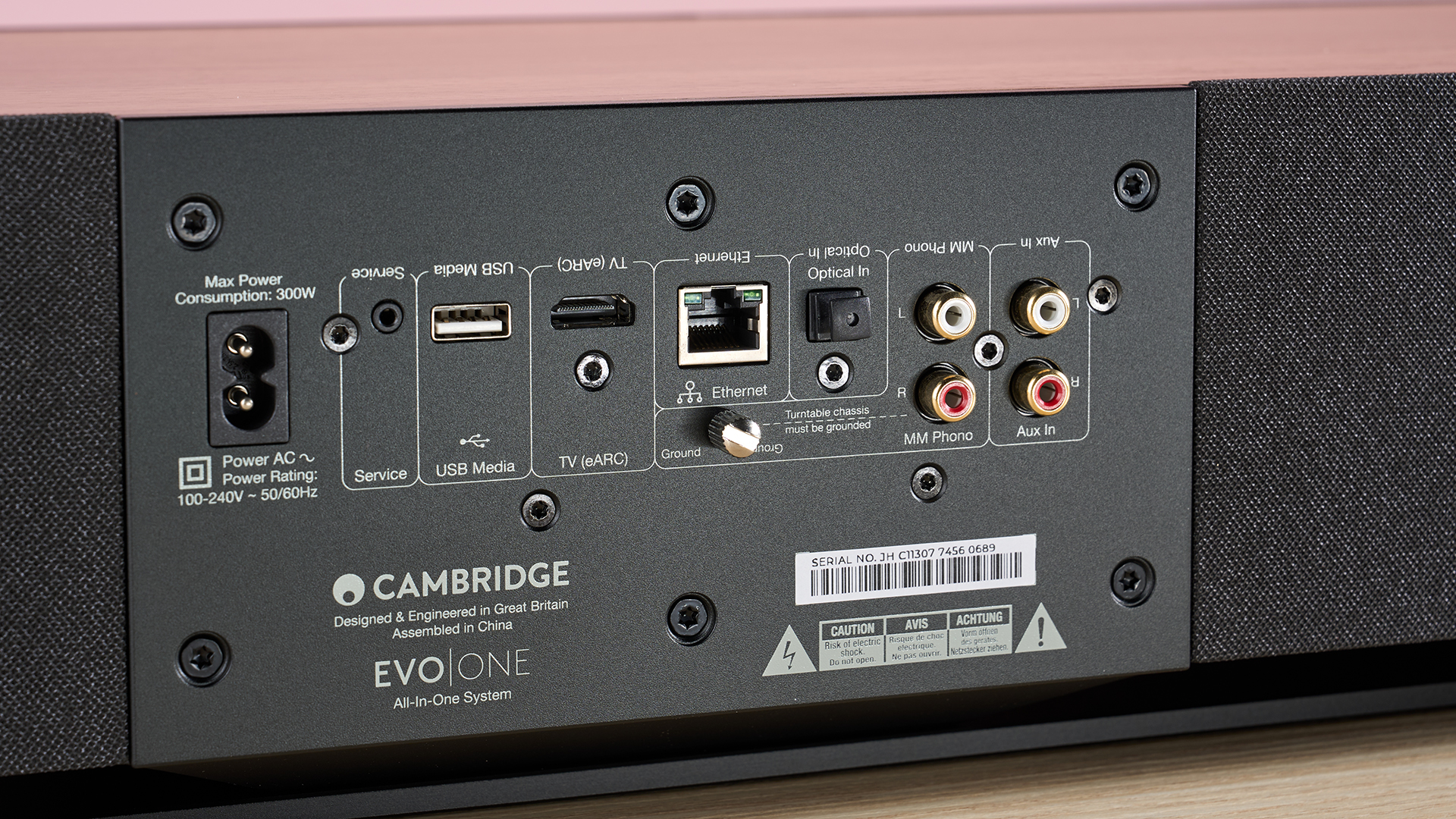
Should I buy the Cambridge Audio Evo One?
Attributes | Notes | Rating |
|---|---|---|
Features | The range of features it offers is truly staggering, acting more like a hi-fi than a single speaker. | 5/5 |
Sound quality | Sounds rich and gorgeous, with precise yet roomy sound. While it doesn’t have height channels or the widest soundstage, it’s still deeply impressive. | 4.5/5 |
Design | Premium, well-built and with a decent display, this makes a stylish addition to any living space. | 4.5/5 |
Value | The Evo One is undeniably expensive. But comparing like for like, there aren’t any other rivals offering such vibrant sound or well-rounded features for less money. | 4/5 |
Buy it if…
You want a feature-packed single-unit speaker
The Evo One is an impressive all-in-one package, taking the place of four or five home audio separates. So if you want a set-it-and-forget-it sound solution that minimizes the cable chow mein choking up your living room, this is a very good option.
You want lush, confident sound
When properly optimized and fed some hi-res material, the Evo One offers exquisite balance and impressive separation of different elements. It’s a polished and impressive performer that will happily sit as the jewel in the crown of your multi-room speaker setup.
Don’t buy it if…
You actually want a soundbar
Stop the presses: the Evo One isn’t one. It’ll add some much-needed poise and gravitas to soundtracks, but if you’re expecting height channels and a wide soundstage, you really do need to invest in an actual soundbar.
You’re looking to save some cash
No two ways about it: the Evo One is an expensive speaker. At $1,499 / £1,299 / AU$2,495, it’s more comparable to the Ruark R410 or the Bang & Olufsen Beosound A5 – you’re paying a premium price for a premium speaker.
Cambridge Audio Evo One review: also consider
| Header Cell - Column 0 | Cambridge Audio Evo One | Naim Mu-so 2nd Gen | Bowers & Wilkins Zeppelin Pro |
|---|---|---|---|
Speaker drivers | 4 x 1-inch silk dome tweeters, 4 x 2.25-inch aluminum cone mid-range drivers, 6 x 2.75-inch long-throw woofers | Stereo 3-way; DSP-optimized vented box acoustic system | 2 x 1-inch Titanium dome tweeters, 2 x 3.5-inch FST, 1 x 6-inch woofer |
Amplification | 700W (14 x 50W) | 450W (6 x 75W) | 240W |
Dimensions | 26.6 x 5.1 x 11.4 inches (675 x 129 x 290mm) | 9.44 x 4.72 x 24.4 inches (246 x 122 x 628mm) | 8.3 x 25.6 x 7.6 inches (210 x 650 x 194mm) |
Connectivity | Wi-Fi 5, Bluetooth 5.1, USB-C, eARC, TOSlink, Ethernet, line-in, phono-in | Wi-Fi 5, Bluetooth 4.2, USB, Ethernet, ARC, optical, 3.5mm jack | Bluetooth 5.0 |
Streaming support | Internet radio, Tidal Connect, Spotify Connect, Qobuz, Deezer, Google Cast, AirPlay 2, Roon Ready | Internet radio, Tidal Connect, Spotify Connect, Apple AirPlay 2, Google Cast, Qobuz, Roon Ready | Tidal Connect, Spotify Connect, Apple AirPlay 2, Deezer, Qobuz |
Other features | Multi-room streaming, room customization, inbuilt phono stage, 7-band EQ, remote control | Multi-room streaming, Party Mode | Multi-room streaming |
Naim Mu-so (2019)
If you love the form factor and are yearning for superlative-sounding, hi-res streaming without extra features such as a phono stage or eARC, but for a lower price in exchange, the Naim Mu-so 2nd Gen is an excellent choice. At $1,299 / £899 / AU$1,299, it's a powerful and impressive speakers, as our full Naim Mu-so (2019) review explains.
Bowers & Wilkins Zeppelin Pro
Following in the footsteps of the classic airship-shaped iPod dock from the 2000s, the Zeppelin Pro is a powerful wireless speaker capable of rich, hi-res sound. Admittedly it’s less talented than the Evo One – again, there’s no connectivity options like phono in or eARC and it has considerably fewer drivers. But it is much more affordable, coming in at just $799 / £699 / AU$1,349, and still sounds exquisite for the price, as we dig into in our full Bowers & Wilkins Zeppelin Pro review.
How I tested the Cambridge Audio Evo One
- I tested it for a month
- I used it for a wide range of audio, from hi-res streams to TV audio via eARC
- I have decades of experience using and reviewing audio gadgets
I tested the Cambridge Audio Evo One over the course of a month. First of all, I used the TechRadar testing playlist, as well as many of my own standard testing tracks, to see how its sound stacked up. I listened to a wide range of different sources, from hi-res streaming on Tidal to Spotify’s lowest-quality tier to see how it coped with different audio quality.
I also tested all of its additional features. I listened to several vinyl albums, both via line-in and through its built-in phono stage, using my Audio-Technica AT-LP60XBT. I also connected it to my TV via eARC and tested its AV sound by watching multiple TV shows and movies. Finally, I tweaked its various sound optimization settings, and played with the EQ settings to test out how they impacted the sound balance.
I’ve spent many years covering audio gadgets, from headphones to speakers, and use a wide variety of sound setups at home, from Bluetooth speakers to my system of hi-fi separates. On top of this, I’ve spent decades making and producing music, which has given me a great deal of insight into how to assess the balance of frequencies and breadth of soundstage.
- First reviewed: February 2025
- Read more about how we test

Josh is Reviews Editor at TechRadar. With over ten years of experience covering tech both in print and online, he’s served as editor of T3 and net magazines and written about everything from groundbreaking gadgets to innovative Silicon Valley startups. He’s an expert in a wide range of products from Spatial Audio headphones to gaming handhelds. When he’s not putting trailblazing tech through its paces, he can be found making melodic techno or seeking out the perfect cold brew coffee.
You must confirm your public display name before commenting
Please logout and then login again, you will then be prompted to enter your display name.
